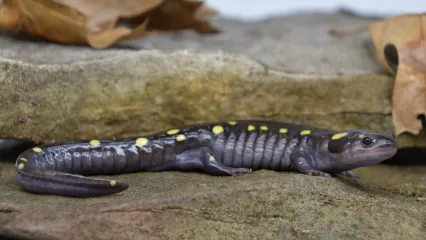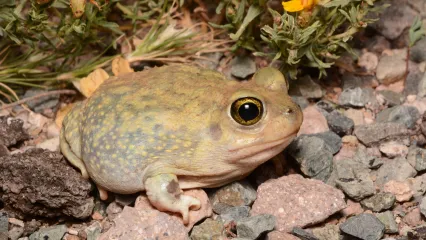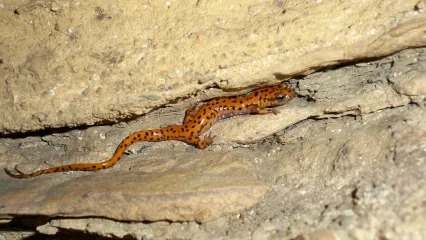
Description
Spotted salamanders are moderately large, stout salamanders with moderately large heads and large eyes. Their name derives from their color pattern, which is black above with round orange spots on the head and round yellow spots on the body and tail. The lower lateral surfaces and underside are light gray to white with no markings. The tail is laterally compressed and has no fin. These characteristics alone distinguish spotted salamanders from other species.
Size
This species can reach more than 9 inches in total length. Most adults vary from 4 to 8 inches in total length.
Habitat
The distribution of spotted salamanders in North America extends west to east from south-central Oklahoma through the entire eastern United States and north to south from southern Canada to near the Gulf Coast of Alabama and Mississippi.
Life Cycle
Like other species of mole salamanders (genus Ambystoma), spotted salamanders spend most of the year underground, except for when they breed. Adult spotted salamanders migrate to temporary ponds during rainstorms in late winter and early spring (usually late January through March). Once in ponds, courtship occurs and males deposit a spermatophore on the pond bottom and females pick up the spermatophore with their cloaca. Once the eggs have been fertilized, females deposit clutches varying in size from as few as 20 eggs to more than 300. Egg masses are attached to sticks, vegetation, or leaves in the water. The small eggs (about one-eighth of an inch in diameter) hatch in 30 to 40 days and the larvae remain in the ponds until they metamorphose, usually in mid-summer.
Larvae feed on a variety of aquatic invertebrates. As the larvae increase in size, they include larger invertebrates in their diets and occasionally eat other salamander larvae. Adults feed on earthworms, insects, and mollusks.
How To Observe
Spotted salamanders are easy to observe by visiting known breeding ponds at night during the first large rains in mid to late winter. Adults can often be found by turning rotted logs on the forest floor, especially during late winter and early spring.
(This profile was created by Dr. Laurie Vitt as part of a partnership between the Wildlife Department and the Sam Noble Oklahoma Museum of Natural History. It was funded as part of a larger State Wildlife Grant to survey and inventory amphibians and reptiles of the Wildlife Management Areas of Oklahoma: T-35-P-1.)


